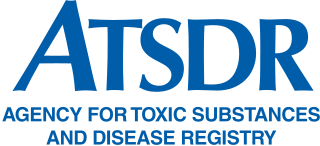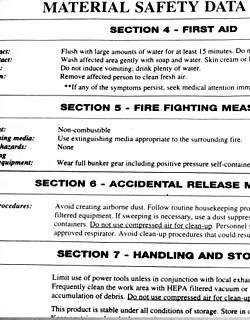Related Research Articles

A personal digital assistant (PDA), also known as a handheld PC, is a variety mobile device which functions as a personal information manager. PDAs have been mostly displaced by the widespread adoption of highly capable smartphones, in particular those based on iOS and Android.

A firefighter is a rescuer extensively trained in firefighting, primarily to extinguish hazardous fires that threaten life, property and the environment as well as to rescue people and animals from dangerous situations.

Environmental health is the branch of public health concerned with all aspects of the natural and built environment affecting human health. Environmental health is focused on the natural and built environments for the benefit of human health. The major subdisciplines of environmental health are: environmental science; environmental and occupational medicine, toxicology and epidemiology.

The Agency for Toxic Substances and Disease Registry (ATSDR) is a federal public health agency within the United States Department of Health and Human Services. The agency focuses on minimizing human health risks associated with exposure to hazardous substances. It works closely with other federal, state, and local agencies; tribal governments; local communities; and healthcare providers. Its mission is to "Serve the public through responsive public health actions to promote healthy and safe environments and prevent harmful exposures." ATSDR was created as an advisory, nonregulatory agency by the Superfund legislation and was formally organized in 1985.

The United States federal Superfund law is officially known as the Comprehensive Environmental Response, Compensation, and Liability Act of 1980 (CERCLA). The federal Superfund program, administered by the U.S. Environmental Protection Agency (EPA) is designed to investigate and clean up sites contaminated with hazardous substances. Sites managed under this program are referred to as "Superfund" sites. There are 40,000 federal Superfund sites across the country, and approximately 1,600 of those sites have been listed on the National Priorities List (NPL). Sites on the NPL are considered the most highly contaminated and undergo longer-term remedial investigation and remedial action (cleanups).

A safety data sheet (SDS), material safety data sheet (MSDS), or product safety data sheet (PSDS) are documents that list information relating to occupational safety and health for the use of various substances and products. SDSs are a widely used system for cataloging information on chemicals, chemical compounds, and chemical mixtures. SDS information may include instructions for the safe use and potential hazards associated with a particular material or product, along with spill-handling procedures. The older MSDS formats could vary from source to source within a country depending on national requirements; however, the newer SDS format is internationally standardized.

The United States National Library of Medicine (NLM), operated by the United States federal government, is the world's largest medical library.

A mobile device is a computer small enough to hold and operate in the hand. Typically, any handheld computer device will have an LCD or OLED flatscreen interface, providing a touchscreen interface with digital buttons and keyboard or physical buttons along with a physical keyboard. Many such devices can connect to the Internet and interconnect with other devices such as car entertainment systems or headsets via Wi-Fi, Bluetooth, cellular networks or near field communication (NFC). Integrated cameras, the ability to place and receive voice and video telephone calls, video games, and Global Positioning System (GPS) capabilities are common. Power is typically provided by a lithium battery. Mobile devices may run mobile operating systems that allow third-party apps specialized for said capabilities to be installed and run.

Occupational hygiene is the anticipation, recognition, evaluation, control, and confirmation of protection from hazards at work that may result in injury, illness, or affect the well being of workers. These hazards or stressors are typically divided into the categories biological, chemical, physical, ergonomic and psychosocial. The risk of a health effect from a given stressor is a function of the hazard multiplied by the exposure to the individual or group. For chemicals, the hazard can be understood by the dose response profile most often based on toxicological studies or models. Occupational hygienists work closely with toxicologists for understanding chemical hazards, physicists for physical hazards, and physicians and microbiologists for biological hazards Environmental and occupational hygienists are considered experts in exposure science and exposure risk management. Depending on an individual's type of job, a hygienist will apply their exposure science expertise for the protection of workers, consumers and/or communities.

Dangerous goods, abbreviated DG, are substances that when transported are a risk to health, safety, property or the environment. Certain dangerous goods that pose risks even when not being transported are known as hazardous materials.
A poison control center is a medical facility that is able to provide immediate, free, and expert treatment advice and assistance over the telephone in case of exposure to poisonous or hazardous substances. Poison control centers answer questions about potential poisons in addition to providing treatment management advice about household products, medicines, pesticides, plants, bites and stings, food poisoning, and fumes. In the US, more than 72% of poison exposure cases are managed simply by phone, greatly reducing the need for costly emergency department and doctor visits.

The Emergency Planning and Community Right-to-Know Act of 1986 is a United States federal law passed by the 99th United States Congress located at Title 42, Chapter 116 of the U.S. Code, concerned with emergency response preparedness.

The Emergency Response Guidebook:A Guidebook for First Responders During the Initial Phase of a Dangerous Goods/Hazardous Materials Transportation Incident (ERG) is used by emergency response personnel in Canada, Mexico, and the United States when responding to a transportation emergency involving hazardous materials. First responders in Argentina, Brazil, and Colombia have recently begun using the ERG as well. It is produced by the United States Department of Transportation, Transport Canada, and the Secretariat of Communications and Transportation (Mexico). The principal authors of the ERG are Transport Canada's Michel Cloutier and U.S. DOT's George Cushmac.

Disaster response is the second phase of the disaster management cycle. It consists of a number of elements, for example; warning/evacuation, search and rescue, providing immediate assistance, assessing damage, continuing assistance and the immediate restoration or construction of infrastructure .The aim of emergency response is to provide immediate assistance to maintain life, improve health and support the morale of the affected population. Such assistance may range from providing specific but limited aid, such as assisting refugees with transport, temporary shelter, and food, to establishing semi-permanent settlement in camps and other locations. It also may involve initial repairs to damaged or diversion to infrastructure.
"Right to know", in the context of United States workplace and community environmental law, is the legal principle that the individual has the right to know the chemicals to which they may be exposed in their daily living. It is embodied in federal law in the United States as well as in local laws in several states. "Right to Know" laws take two forms: Community Right to Know and Workplace Right to Know. Each grants certain rights to those groups. The "right to know" concept is included in Rachel Carson's book Silent Spring.
The Hazardous Substances Data Bank (HSDB) is a toxicology database on the U.S. National Library of Medicine's (NLM) Toxicology Data Network (TOXNET). It focuses on the toxicology of potentially hazardous chemicals, and includes information on human exposure, industrial hygiene, emergency handling procedures, environmental fate, regulatory requirements, and related areas. All data are referenced and derived from a core set of books, government documents, technical reports, and selected primary journal literature. All entries are peer-reviewed by a Scientific Review Panel (SRP), members of which represent a spectrum of professions and interests. Current Chairs of the SRP are Dr. Marcel J. Cassavant, MD, Toxicology Group, and Dr. Roland Everett Langford, PhD, Environmental Fate Group.
Long Island Occupational and Environmental Health Center, is one of the NYS Department of Health (DOH) Occupational Health Clinics (OHC).
The Hazard Communication Standard requires employers in the United States to disclose toxic and hazardous substances in workplaces. This is related to the Worker Protection Standard.
Larry M. Starr is a consultant, academic administrator, university professor, and research scientist. His primary academic affiliation has been at Thomas Jefferson University in Philadelphia where he is Director of the Doctor of Management (DMgt) in Strategic Leadership program and Director of the Doctor of Philosophy (PhD) program in Complex Systems Leadership program. He is also Managing Director of Systems Wisdom a global consultancy which provides translational consulting, executive education, and research specializing in complex and seemingly intractable problems; and he is Executive Director of the Institute of Systems Wisdom an innovative social-academic-practice community. Starr’s practice and research integrate cognitive and personality psychology, emergency and disaster medicine, and systems and design thinking. He is the principal author of the position statement, Automated External Defibrillation in the Occupational Setting, issued by the American College of Occupational and Environmental Medicine (ACOEM) released under the auspices of the ACOEM Council of Scientific Advisors.
GESTIS Substance Database is a freely accessible online information system on chemical compounds. It is maintained by the Institut für Arbeitsschutz der Deutschen Gesetzlichen Unfallversicherung. Information on occupational medicine and first aid is compiled by Henning Heberer and his team.
References
- ↑ "TSP Billions and billions and billions to grab for". Annals of Tourism Research. 4 (1): 54. August 1976. doi:10.1016/0160-7383(76)90057-8. ISSN 0160-7383.
- ↑ "New Hand-held Information System for Emergency Responders". Medical New Today. 12 Mar 2005. Retrieved 9 October 2010.
- ↑ Skhal, Kathryn (January 2006). "Wireless Information System for Emergency Responders (WISER)". Journal of the Medical Library Association, Journal of the Medical Library Association. Journal of the Medical Library Association. 94, 94 (1, 1): 97, 97–97. Retrieved 9 October 2010.
- 1 2 Forman, Steven. "Website Review". Volume 58, Issue 6. Oxford Journals of Occupational Medicine. p. 446. Retrieved 9 October 2010.